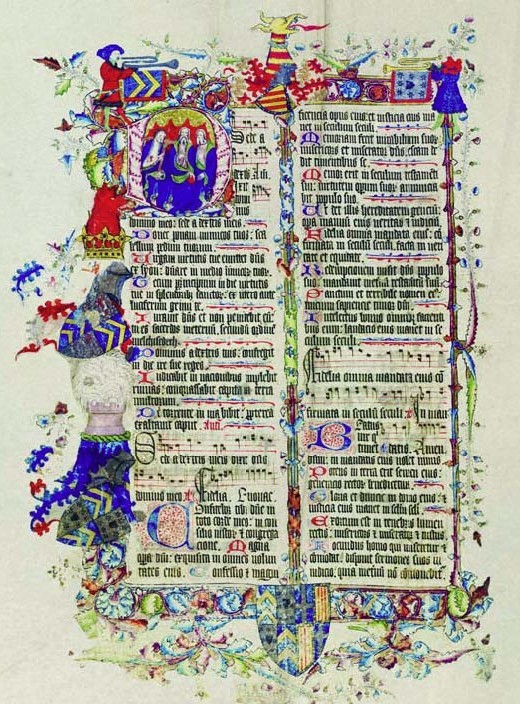Music for Henry V and the House of Lancaster / The Binchois Consort
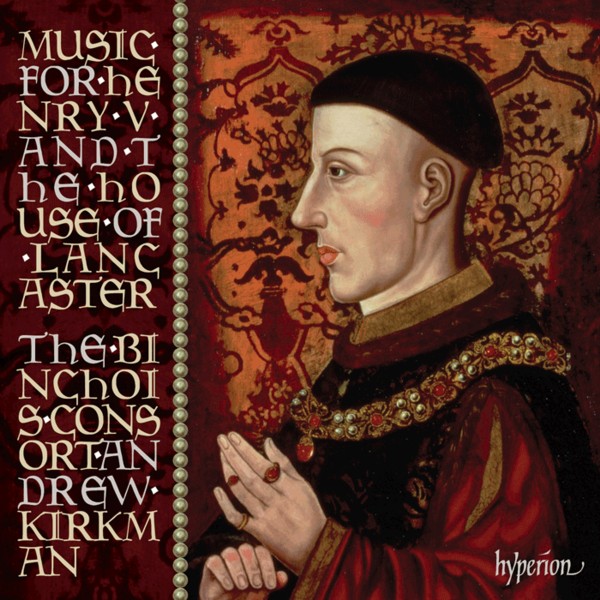
medieval.org
hyperion-records
Hyperion CDA67868
2011
grabado en mayo de 2010
St Silas' Church, Kentish Town, London
01 - 'Roi HENRY', Henry V (1386-1422). Gloria [3:42]
The Office for St John of Bridlington · antiphons &
responsory
02 - 'Johannis solemnitas digne celebretur' [7:05]
03 - Asperges me, Domine [2:41]
chant with faburden
Missa Quem malignus spiritus
04 - 1. Kyrie [6:59]
05 - 2. Gloria [6:28]
06 - Ave regina caelorum [1:15]
chant · solo, Richard Butler
07 - Leonel POWER (d.1445). Ave regina caelorum [2:53]
08 - 3. Credo [7:34]
09 - Gloriosae virginis [0:52]
chant · solo, Christopher Watson
10 - Leonel POWER. Gloriosae virginis [1:39]
11 - 4. Sanctus and Benedictus
[7:38]
12 - [Thomas?] DAMETT (1389/90?-1436/7). Salvatoris mater ~ O Georgi Deo care
[4:13]
13 - John COOKE (c.1385-1442?). Alma proles ~ Christi miles [3:50]
14 - [Nicholas?] STURGEON (d.1454). Salve mater Domini ~ Salve templum gratie
[3:04]
15 - 5. Agnus Dei
[6:18]
16 - Ite missa est ... Agimus tibi gratias [2:01]
17 - Tota pulchra es [2:02]
chant · solo, Timothy Travers-Brown
18 - Walter FRYE (d.1475). Ave regina caelorum [2:35]
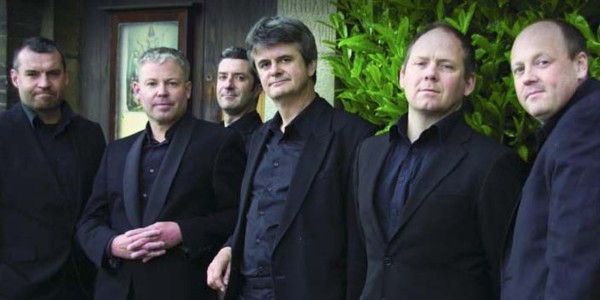
The Binchois Consort
Andrew Kirkman
Mark Chambers, alto
Timothy Travers-Brown, alto
Richard Butler, tenor
Edwin Simpson, tenor
Matthew Vine, tenor
Christopher Watson, tenor
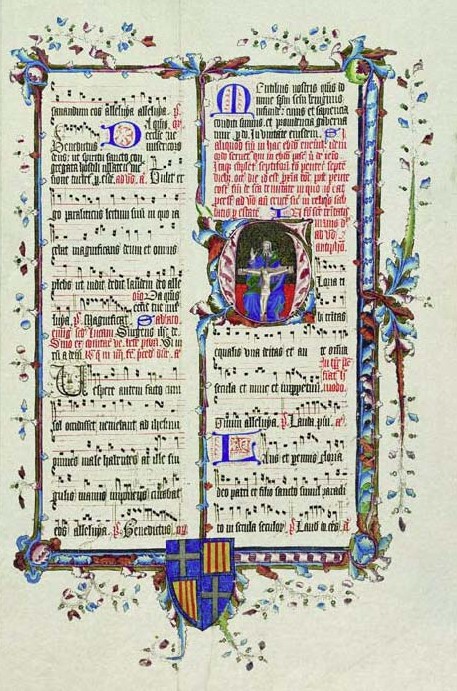
This recording documents in sound
something of the cultural seriousness and panache of the royal princes
of the House of Lancaster. Above all, it seeks to evoke the vocal and
ceremonial beauty of their household chapels. In doing so it celebrates
in music the brilliant, iconic figure of Henry V, hero of Agincourt and
the French campaigns; the obviously unheroic but still culturally and
religiously influential figure of his son, Henry VI; and finally the
perhaps unlikely figure they both revered: John Thwenge (Thwing), a
fourteenth-century Augustinian prior who, as St John of Bridlington,
was to be the last English saint canonized prior to the Reformation. It
also celebrates the great Wollaton Antiphonal, a magnificent
illuminated chant book of the early fifteenth century that uniquely
preserves the melodies of the Bridlington Office and constitutes one of
the finest survivals of the myriad liturgical volumes of
pre-Reformation England, so very few of which avoided falling prey to
the purges and material destruction of the mid-sixteenth century.
Our programme presents a spectrum of English polyphonic vocal styles
spanning the reigns of Henry V and Henry VI, and we have sought to
balance the securely ascribed pieces (by both more and less familiar
names) with the anonymous ones. The programme as a whole articulates a
kind of journey through Lancastrian dynastic concerns, demonstrating as
it does so the sheer variety of types of singing, some of it virtuosic
in its brilliance, available to well-staffed princely chapels in
England at the time. More concretely, it offers sacred ceremonial
pieces written either for Henry V himself, as King, or to invoke the
saintly patron of the House of Lancaster, John of Bridlington, as well
as a group of motets in honorem beatae Mariae virginis.
The Bridlington Mass-setting recorded here dates from the era of his
son and heir Henry VI, though it may or may not have been commissioned
directly for (or indeed from within) the Chapel Royal itself. It is
based on one of the melodies found in the Wollaton Antiphonal (Quem
malignus spiritus), and is presented together with items of English
plainchant and a selection of motets chosen not just for their sonic
qualities, but to illustrate something of the range of styles in use
during the ‘Lancastrian decades’ of the fifteenth century.
These chants and motets are interspersed among the Mass movements,
sometimes as pairs of Latin texts addressed to the blessed virgin Mary,
sometimes as integral parts of the order of Mass. The opening sections
of the Bridlington Office, up to and including the Responsory which
provides the Quem malignus melody, are sung as a kind of
musical preface or introduction, beginning at Johannis solemnitas.
(As was common in Office chants of the Sanctorale, the various
component texts stay very close to the narrative of the life of the
saint whose feast was being celebrated, so that anyone listening or
participating would be reminded of the relevant stories as the liturgy
progressed.) The Asperges me, part of the penitential rite at
the beginning of Mass, is then performed to Sarum chant, with the
‘refrain’ being sung to improvised three-voice polyphony (a
widespread and characteristic tradition, known in England as
‘faburden’). The conclusion of Mass is marked by a short
‘post missam’ motet for three voices, Agimus tibi
gratias, that in time-honoured fashion answers the priest’s
dismissal Ite missa est (‘Go, the Mass is ended’).
There are three chant/motet pairings dedicated, rather like votive
offerings in sound, to the virgin Mary: Gloriosae virginis, Ave
regina caelorum and the much-loved Tota pulchra es, which
is paired with another Ave regina setting. There is also a
group of three extended motets addressed jointly to Mary and St George,
as prime intercessors for the kingdom of England (Salvatoris mater,
Alma proles and Salve mater). These motets, written by
musicians of Henry V’s own chapel, are without doubt political
pieces, in a religious and ceremonial sense, reflecting the bellicose
history of Henry’s reign with its central victory of Agincourt,
and the King’s vital position in relation to the English realm
and people at that momentous time. There were celebrations in London
following on from the victory itself—an event that was
mythologized almost as soon as it had happened, and had already passed
into national legend long before Shakespeare and Burbage, let alone
Garrick, Kean, Olivier and the rest. Motets played a key role in both
the quotidian and the occasional rituals of Henry’s reign, one
key event having been the performance of a (now lost) motet Ave rex
Anglorum / Flos mundi / Miles Christi—which no doubt
expressed sentiments similar to those of the surviving trio of
motets—before the gate to London Bridge to herald the
King’s entry into the city following his great victory in 1415.
The motets may well belong together as a group, which is how they
appear in the Old Hall manuscript, couched among the Sanctus and
Benedictus settings—and so this is how we present them here, at
the appropriate point within the Mass liturgy after the Sanctus (the
outer two are based on the two ‘halves’ of a divided
Benedictus chant, split at the word ‘ve-nit’). The central
motet has the invocation ‘Christ, defend us from our
enemies’, and makes a general plea for divine support for both
state and people, as well as for the King himself, in time of war.
The Missa Quem malignus spiritus is an extended cantus firmus
setting based on the chant extracted from the Bridlington Office. It
was evidently quite widely known and performed, surviving as it does in
as many as four sources (two of which are in fact the same version
copied twice). In particular, it survives (in only fragmentary form) in
the so-called Lucca Choirbook, a musically substantial manuscript
collection of great historical interest that was written circa 1463, in
Bruges, probably for use in the chapel of the English Nation of
Merchant Adventurers (whose governor William Caxton, a long-time
resident of Bruges, had recently become). The chant melody in
(relatively) long note values is given in the lower of the two tenor
voices, and in our recording has been sung to its original Bridlington
text. The high tenor and discantus parts form an integrated pair of
voices above this, and are written with a degree of rhythmic interplay
and melodic imitation that gives a sense of tautness and momentum to
the texture as a whole. This is exceptional, yet not uncharacteristic,
for English music at this period. It is becoming clearer, the more the
repertory is explored and investigated in greater depth, that there was
a really wide range of vocal idiom and compositional style operative in
England during this era. And the anonymous status of so many important
works, including such pieces as the Bridlington Mass and the iconic Missa
Caput, can only serve to sharpen our awareness of this situation,
standing as they do beyond what we (often too readily and uncritically)
see as the self-consistent personal styles of the best-known composers.
The Quem malignus Mass was evidently conceived for a skilled
ensemble of singers, whose art seems to have left its mark upon the
polyphony—its clearness of line, its sense of rhythmic focus and
balance, and the general elegance of its solutions to the problem of
presenting the liturgical texts in cogent phrases, while offering at
the same time a real sense of articulate musical flow, are all evidence
of this. It undoubtedly reflects the professional world of the
Lancastrian chapels, and those of the important noble families
associated with them (Beauchamp and Beaufort, for example). It is a
very individualized piece, and one not easily susceptible to close
linkage with others; perhaps the work that offers the closest points of
analogy is Frye’s beautiful Nobilis et pulchra Mass,
although this relationship ought not to be exaggerated. For the
present, the proud anonymity of the Missa Quem malignus spiritus
(like that of the Caput Mass, indeed) will remain one of its
distinguishing characteristics.
Like the Mass, the anonymous three-voice Agimus tibi gratias is
also found in the Lucca Choirbook. It is one of a group of (presumably)
English motets written together in the manuscript, that are for use at
the end of the liturgy (blessing and dismissal); and we may be certain
that at some time or other it was heard at Mass in Bruges together with
the Missa Quem malignus spiritus, the two being sung from the
manuscript they shared.
The four-voice motets Gloriosae virginis and Ave regina
caelorum are jewels of the art of Leonel Power. These pieces are
not long, but their sense of compactness is lightened and dispelled by
the exquisite control of line and sonority which they exhibit. Their
finely judged and ‘easy’ intricacy lifts them into a
time-dimension where a musical moment or phrase may be neither long nor
short, but simply of a perfect duration. Moreover their sound is
distinctive and individual, as well as beautiful—this is an idiom
unlike any other at that period, even in England, and creates a sense
of space and luminosity through the masterly interplay of its musical
elements. These short antiphon texts are set as a combination of votive
offering and gently impassioned invocation, freely alluding to their
respective chants as they do so.
The Frye Ave regina caelorum was one of the most widely copied
and evidently best-loved motets of the entire fifteenth century. It
survives in a wide range of sources, was depicted in visual art being
sung by angels, and was reworked in keyboard arrangements and with
expanded vocal textures. Our version is in four voices, and is
transmitted in a source as far away as late fifteenth-century Bohemia.
The chant for St John and the succession of the Mass are prefaced by a
Gloria, found in the Old Hall manuscript as one of two pieces by
‘Roy Henry’, very probably Henry V himself. That a royal
personage should have been a literate musician, no doubt well versed in
the arts of singing and musical leisure in addition to those of
composition, as well as being very conscious of the personal interest a
royal prince ought to take in the musical and ceremonial ordering of
his chapel, is on the face of it surprising. Yet as we have seen, the
Lancastrians offer, in the vigour of their cultural as well as military
prowess, the very archetype of a complete prince in a way that stands
as a model for the later Middle Ages, and yields nothing to the
princely ideal of later decades. In Henry V’s case, as in that of
Charles the Bold later in the century, this engagement with the art of
music was clearly a skilled and active involvement.
If the English music of the fifteenth century still has the power to
speak to us today, with its individuality of sound, its particular
beauty and sense of aesthetic priorities, then that is all of a piece
with the fame it enjoyed in its own time. For several generations it
was valued and performed both at home and abroad, occupying a leading
position on the European stage from Italy and France in the west to
musical communities far away in Germany and central Europe. It was sung
in the most prestigious chapels and ecclesiastical centres, but also in
far-flung places which one might hardly expect English music to have
penetrated. This was one of those few moments when English music was at
the very forefront of European developments, and was openly
acknowledged to be so by European masters. No group of aristocratic
patrons did more to foster the emergence of such a situation than the
princes of the House of Lancaster.
PHILIP WELLER © 2011
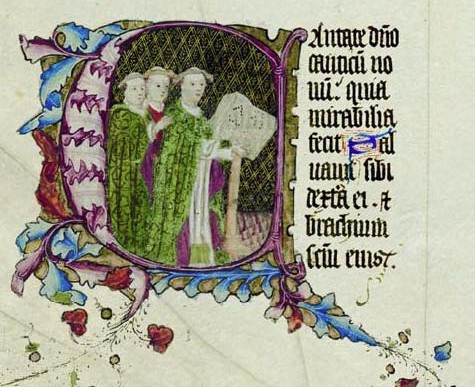
The Bridlington & Missa Quem malignus Project
THIS PROJECT grew out of a very specific, practical brief: to devise a
concert programme for an event that would celebrate in music the
process of conserving the Wollaton Antiphonal, and the new phase of
intensive study to which this process has given rise. (Parts of the
Antiphonal were shown in an exhibition of the Wollaton medieval
manuscripts which ran from April to August 2010 at the University of
Nottingham; there was a public research colloquium on the significance
of the Antiphonal for polyphonic music on 4 May followed by a one-day
conference on 8 May, together with the evening concert given by The
Binchois Consort.) The research, planning and preparation for the
concert opened up new areas of interest and significance and led to the
present recording, which brings the Bridlington material and its story
into close relation with Henry V, his son Henry VI, and the House of
Lancaster.
The House of Lancaster: Princes, Patronage, Music
As men and monarchs, Henry V and his heir Henry VI could scarcely have
been more different. Despite being father and son, and (in theory at
least) schooled to the same role and the same tasks, they were about as
dissimilar as could be imagined. Henry V was the great warrior, with
tremendous reserves of character and strength of purpose, whose
personality and achievement both on and off the battlefield became the
stuff of myth even in his own lifetime. The admiration he enjoyed and
the loyalty he commanded were of heroic proportions. Henry VI, by
contrast, was the would-be conciliator, whose gentler nature and
perhaps too-scrupulous indecision and anxiousness made him a weak
leader—a king at the furthest possible remove from his father.
Yet the two men were alike in their keen promotion of music. This was
especially true of Latin sacred music for the ceremonial operations of
the chapels they supported: the celebration of Mass and of Vespers, as
a sign of their princely dignity and the divine order of their earthly
rule. On this level, our concert and recording project has brought them
closer together than they ever were in life. For while they were
separated in history by the tide of events, and in posterity by our
rather fixed view of their divergent personalities and destinies, they
resembled one another in their keen appreciation and patronage of
polyphonic art music, and of the working musical institutions needed to
support it.
Between them, the Lancastrian princes—Henry and his brothers
Clarence and Bedford, essentially, and later the younger
Henry—employed most of the famous composers of the era at one
time or another. The sense of high-level collective musical endeavour
was crucial to the development of strong musical personalities, the
fruits of whose labours expanded the horizons not only of English but
of European music. The Lancastrians contributed to this in a huge way.
As royal figureheads, they brilliantly displayed an all-round package
of strengths, virtues and accomplishments: their aristocratic personae
and the organization of their entourage offered a palpable sense of
richness and dignity. This was part of the aura of power and kingship;
and their sense of display—including the best available sacred
music, sung by the best singers— helped to maintain that aura.
The functional needs of princely ceremonial, and the technical and
aesthetic needs of maintaining a brilliant musical establishment and
its associated repertoire, went hand in hand. Henry V may have been the
quintessential soldier and leader of men; but he also embodied to a
remarkable degree the arts of peacetime and good governance, too, as
the early fifteenth century understood them. He was in this sense an
important agent of cultural as well as political and military history.
In him we can easily observe how the nature of the man and the
performance of his role, with its many associated tasks and duties,
together contributed to the strong projection of his kingly identity.
His son Henry VI was by contrast no great leader, a peaceable man whose
reputation has understandably suffered by the comparison with that of
his father. But the younger Henry was among other things a religious
patron of great energy and commitment, the results of whose activity
(as distinct from his historical reputation) have in some instances
outlived and outshone those of his father—as for example in his
great collegiate foundations at Eton and Cambridge. And the fact that
many such colleges were from the very beginning set up as places where
polyphonic music was to be cultivated, and the relevant singing and
composing skills carefully nurtured, relates directly to the
flourishing state of English music throughout the fifteenth century, to
the vigour of its traditions, and to its international fame.
Lancastrian Devotion to St John of Bridlington
But there is a further strand to our project: the presence of St John
of Bridlington, the last English saint to be canonized prior to the
Reformation, and—chiefly through the agency of Henry IV—a
patron saint of the House of Lancaster. The Bridlington threads
contribute in no small measure to the colour and texture of our
tapestry. The early years of the fifteenth century saw an increased
attention given to English saints, not least by the Lancastrians. The
famous east window in the Beauchamp chapel at St Mary’s, Warwick
bears eloquent testimony to this: in the upper level of the window we
see, on the left, St Alban and St Thomas Becket, and on the right,
Saints Winefred and John of Bridlington. As major political and
administrative players in the affairs of the kingdom, the Beauchamps
were a key part of the network of alliance positioned around the House
of Lancaster, sustaining it and extending its influence. In such a
context, the presence of the ‘Lancastrian St John’ among a
group of English saints that was clearly intended to be representative
and emblematic is striking and significant. (It is easy to imagine any
of the professional male-voice ensembles employed by the
Lancastrian-related families as part of their household chapels singing
the Missa Quem malignus in the context of their liturgical
duties; musically it would have been very suitable for just this kind
of purpose—and it must surely have sounded in the chapel at
Warwick, in the presence of the richly coloured image of the saint
himself.)
Partly, the emphasis on English saints was a matter of cultural
identity; but it was a question of politics as well. National and
regional relationships were being renegotiated during the fourteenth
and fifteenth centuries, even as the Hundred Years War and the Wars of
the Roses were being played out (over decades, rather than years). The
exigencies of place and power formed part of this process of
renegotiation; and so far as the expression of loyalty and nationhood
was concerned, authority and solidarity resided as much in securely
located, culturally grounded religious tradition as in force of arms or
jurisdiction. This is one strong reason, no doubt, why the cult of John
of Bridlington became an important factor for Henry IV and his
descendants. He was a regional saint, whose shrine was within easy
striking distance of their ancestral stronghold at Bolingbroke in
Lincolnshire, and may well have been thought of as offering a kind of
resistance, or better: a kind of positive rivalry, to the rising cult
of Archbishop Scrope at York.
This was doubly important because Henry IV had had Scrope executed for
treason after the confrontation at Shipton Moor—and the last
thing he wanted was a renewal of the York-based rebellion in the form
of a popular uprising fuelled by religious feeling, and focused on a
local ‘martyr’ to the Yorkist cause. Such a sense of
urgency to match the strength of political and military power with the
strength of ceremonial and cultural display was accentuated for the
Lancastrians not least because they were usurpers. The energy with
which they pursued this was genuinely heroic; and there is little doubt
that their sense of the need to invoke divine aid, or at least seek
divine approval, was part of their way of dealing positively with the
dynamics of their situation.
The Lancastrian revolution (there is no other appropriate word) of 1399
brought them to power, but there was resistance on every side. The
psychological need to find, and feel, support from on high was probably
overwhelming. And there is no doubt whatever that Henry V did in fact
take his religious obligations, especially those towards the saints,
very seriously indeed; a devoutness stemming at least in part from the
moral exhortations of Thomas Hoccleve, whose Regement of Princes
had been written for him and presented to him prior to his accession,
in 1411, when he was still Prince of Wales. As in all things, however,
he fulfilled his duties not just pro forma but decisively, with heroic
energy.
On his royal tour in 1421 he made special pilgrimages to shrines he
judged of particular importance, including Howden, Beverley and
Bridlington in Yorkshire, as well as travelling from Lincoln to Lynn
and then Walsingham in Norfolk. It was thought that St John of Beverley
had intervened—or at least, interceded—on behalf of the
English so as to ensure the victory at Agincourt, and that his shrine
had sweated holy oil as a mark of this. (Agincourt was fought on 25
October which, in addition to being the feast of Saints Crispian and
Crispinian, as Shakespeare reminds us with insistence, is the feast of
the Translation of St John of Beverley, as observed in the diocese of
York; at Henry’s request Archbishop Chichele ordained various
forms of enhanced liturgical observance for St John the following year,
1416.)
PHILIP WELLER © 2011
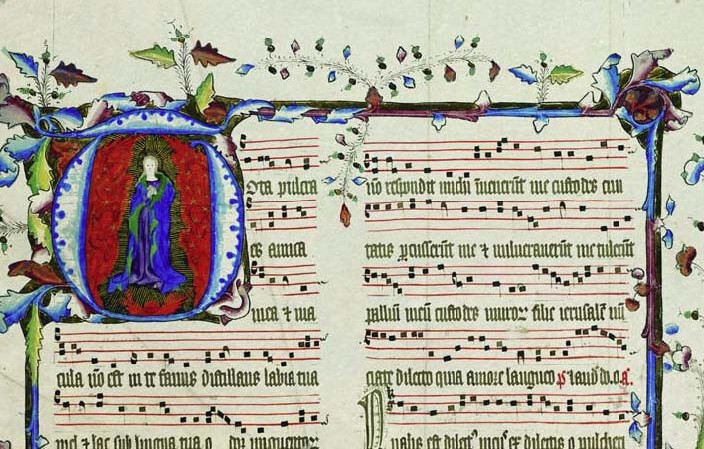
The Wollaton
Antiphonal
As indicated above, the conservation project has been allied with new
historical and interpretive research on the Antiphonal. This research
is in turn framed within a larger project devoted to the collection of
medieval manuscripts of Wollaton Hall Library, where the Antiphonal
resided from the mid-sixteenth century until Christmas 1924. It
belongs, as it did in the later fifteenth century, to the parish church
of St Leonard’s; but it was as a result of having been kept in
the family library at Wollaton Hall that the Antiphonal miraculously
escaped the purges and destruction of the Henrician Reformation.
The Antiphonal is a sumptuous illuminated medieval service book
produced in the early fifteenth century (most probably in East Anglia)
for Sir Thomas Chaworth (1380–1459), an enormously wealthy
magnate and bibliophile, and one of the most prominent noblemen in the
East Midlands. Influential and very active in public life, in addition
to being rich and well connected, he was related to the
Plantagenet-Lancasters through a common ancestor, the first Sir Patrick
de Cadurcis (the original form of Chaworth), and seems to have
commissioned the genealogical additions to the famous Chaworth Roll,
that brought his very distinguished family tree up to date, in the
early years of the fifteenth century. This strong connection to the
House of Lancaster (as a young man he had fought at Agincourt with
Henry V, with a force of eight men-at-arms and twenty-four archers)
probably explains why he might have had a personal—and also
dynastic—investment in his devotion to John of Bridlington. He
would have sought to maintain and express that devotion as a mark of
his Lancastrian loyalty, as other great families such as the Beauchamps
and Beauforts would also have done. Moreover, he seems to have had a
special allegiance to the Augustinians: he was buried with his wife in
an Augustinian house, Launde Abbey in Leicestershire, where he had
previously founded a chantry. So there is every likelihood that the
Bridlington Office may have been copied (as a special addition) into
the Antiphonal at his instigation, some time between the book’s
completion circa 1430 and his death in 1459.
He may have viewed his prized liturgical manuscripts (in part at least)
as luxury cultural objects. Certainly, their visual and artistic
aspects were important to him. But there seems little doubt that he
valued them for their religious significance as well, perhaps even
primarily; and this then fits in very well with what we know of the
acts and attitudes of conventional piety that characterized his later
years. His combination of immense wealth with a genuine religious
sensibility was a fairly common one among the medieval nobility, and
quite naturally found expression in bequests to religious communities
and institutions, and in the purchase of extravagantly expensive
devotional and liturgical books. If the stylishly adorned Book of Hours
was the usual acquisition (the ‘must have’ accessory of
choice for fashionable devotion), the purchase of formal liturgical
books may not in itself have been all that rare, though the sheer size
and splendour of Chaworth’s Antiphonal must surely have been
exceptional.
Besides the Bridlington Office itself, entered on separate leaves of
vellum at the end of the Sanctorale, there are other additions
to the book that are specific to the Use of York, or to the Willoughby
family and to Wollaton in Nottinghamshire, which date from the later
phase of the book’s existence once it had passed into the
possession of the parish church of St Leonard’s, soon after Sir
Thomas’s death in 1459. It probably came to the church through
the good offices of Richard Willoughby (d1471) of Wollaton Hall (the
old hall, which stood close by the church), who was Chaworth’s
chief executor; and it was paid for out of the estate of the rector of
Wollaton, William Husse, who died in 1460. The close physical study of
the manuscript has opened up a new phase of interpretive and contextual
study, which is proving to be of real fascination and historical
interest. Handwritten changes are present in the Calendar, including
the addition of York feasts and the listing of Willoughby obits and
commemorations, and also the feast of dedication of Wollaton church.
Other handwritten entries, and the glorious heraldic illuminations,
tell their own story vividly; and it is the matching of these visual
elements with our knowledge of the book’s history that speaks
eloquently to us of the practical, everyday use to which it was put,
despite its extreme richness as a visual object.
The written image of music has a fascination all its own. Not just the
striking visual character and precision of the notational symbols, and
also (in the best cases) the clarity and elegance of the script, but
the whole conception and layout of the musical book have the power to
fix our attention. And this is true whether the book is a liturgical
volume, a collection of polyphony, or indeed, in later music, a
composer’s autograph. The Wollaton Antiphonal demonstrates very
well the extraordinary beauty of the finest kind of liturgical book
production of the early fifteenth century in England. (It came, almost
certainly, from a skilled East Anglian scriptorium and
illuminator’s workshop around 1430.) The arresting mise en
page for the beginning of Psalm 109 (fol. 246v) displays the
technical virtuosity as well as the visual brilliance of the
illuminators. Its decorative scheme shows the Trinity, and also
illustrates some of the armorial designs which proclaimed the status
and pedigree of Sir Thomas Chaworth, the original owner of the
Antiphonal, and his wife Isabella. The image of the singing clerics
also illustrates the first verse of a Psalm text (Psalm 97, fol. 241v).
The page showing the beginning of the Office of the Assumption (fol.
369r) comes, like the Psalm leaves, from the main body of the volume,
while the two leaves showing sections of the Bridlington chant (fols.
411r-v) are an addition: they come at the very end of the Antiphonal,
appended to the section devoted to the feasts of the Saints.
As indicated elsewhere, the community of the parish church of St
Leonard’s, Wollaton were owners of the manuscript from 1460 and
again from Christmas 1924 when it was once more returned to their
possession. Were it not for the fact of their custodianship of the
Antiphonal, and of its having been kept safe in the interim in the Hall
library from the ravages of the Reformation, we would never have had
the music of the Bridlington Office at all, and our scenario would have
been much less complete. Thanks are due to the church for their
generosity in wishing to share what is in their possession, and for
participating in the telling of an extraordinary story. Thanks are due
as well to all those who have worked, both in the church and later in
the Nottingham University Library, to look after and maintain this
precious book, and finally, not least, to the man who—with no
little courage—took the first great plunge towards the immense
task of conserving the Antiphonal in its entirety: Nicholas Hadgraft
(1955–2004).
PHILIP WELLER © 2011
